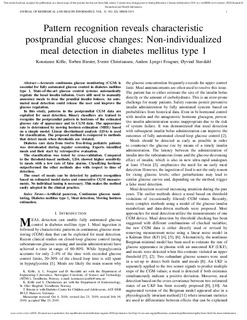| dc.contributor.author | Kölle, Konstanze | |
| dc.contributor.author | Biester, Torben | |
| dc.contributor.author | Christiansen, Sverre | |
| dc.contributor.author | Fougner, Anders Lyngvi | |
| dc.contributor.author | Stavdahl, Øyvind | |
| dc.date.accessioned | 2019-04-15T06:14:36Z | |
| dc.date.available | 2019-04-15T06:14:36Z | |
| dc.date.created | 2019-03-28T12:24:46Z | |
| dc.date.issued | 2019 | |
| dc.identifier.citation | IEEE journal of biomedical and health informatics. 2019, 23 . | nb_NO |
| dc.identifier.issn | 2168-2194 | |
| dc.identifier.uri | http://hdl.handle.net/11250/2594559 | |
| dc.description.abstract | Accurate continuous glucose monitoring (CGM) is essential for fully automated glucose control in diabetes mellitus type 1. State-of-the-art glucose control systems automatically regulate the basal insulin infusion. Users still need to manually announce meals to dose the prandial insulin boluses. An automated meal detection could release the user and improve the glucose regulation. In this study, patterns in the postprandial CGM data are exploited for meal detection. Binary classifiers are trained to recognize the postprandial pattern in horizons of the estimated glucose rate of appearance and in CGM data. The appearance rate is determined by moving horizon estimation (MHE) based on a simple model. Linear discriminant analysis (LDA) is used for classification. The proposed method is compared to methods that detect meals when thresholds are violated. Diabetes care data from twelve free-living pediatric patients was downloaded during regular screening. Experts identified meals and their start by retrospective evaluation. The classification was tested by cross-validation. Compared to the threshold-based methods, LDA showed higher sensitivity to meals with a low rate of false alarms. Classifying horizons outperformed the other methods also with respect to time of detection. The onset of meals can be detected by pattern recognition based on estimated model states and consecutive CGM measurements. No individual tuning is necessary. This makes the method easily adopted in the clinical practice. | nb_NO |
| dc.language.iso | eng | nb_NO |
| dc.publisher | Institute of Electrical and Electronics Engineers (IEEE) | nb_NO |
| dc.subject | Måltidsdeteksjon | nb_NO |
| dc.subject | Meal detection | nb_NO |
| dc.subject | Type 1 diabetes | nb_NO |
| dc.subject | Kontinuerlig glukosemåling | nb_NO |
| dc.subject | Continuous glucose measurement | nb_NO |
| dc.subject | Mønstergjenkjenning | nb_NO |
| dc.subject | Pattern Recognition | nb_NO |
| dc.title | Pattern recognition reveals characteristic postprandial glucose changes: Non-individualized meal detection in diabetes mellitus type 1 | nb_NO |
| dc.type | Journal article | nb_NO |
| dc.type | Peer reviewed | nb_NO |
| dc.description.version | acceptedVersion | nb_NO |
| dc.subject.nsi | VDP::Medisinsk teknologi: 620 | nb_NO |
| dc.subject.nsi | VDP::Medical technology: 620 | nb_NO |
| dc.source.pagenumber | 9 | nb_NO |
| dc.source.volume | 23 | nb_NO |
| dc.source.journal | IEEE journal of biomedical and health informatics | nb_NO |
| dc.identifier.doi | 10.1109/JBHI.2019.2908897 | |
| dc.identifier.cristin | 1688517 | |
| dc.relation.project | Norges forskningsråd: 248872 | nb_NO |
| dc.relation.project | Samarbeidsorganet mellom Helse Midt-Norge og NTNU: 46075403 | nb_NO |
| dc.description.localcode | © 2019 IEEE. Personal use of this material is permitted. Permission from IEEE must be obtained for all other uses, in any current or future media, including reprinting/republishing this material for advertising or promotional purposes, creating new collective works, for resale or redistribution to servers or lists, or reuse of any copyrighted component of this work in other works. | nb_NO |
| cristin.unitcode | 194,63,25,0 | |
| cristin.unitcode | 194,65,15,0 | |
| cristin.unitname | Institutt for teknisk kybernetikk | |
| cristin.unitname | Institutt for klinisk og molekylær medisin | |
| cristin.ispublished | false | |
| cristin.fulltext | postprint | |
| cristin.qualitycode | 1 | |
